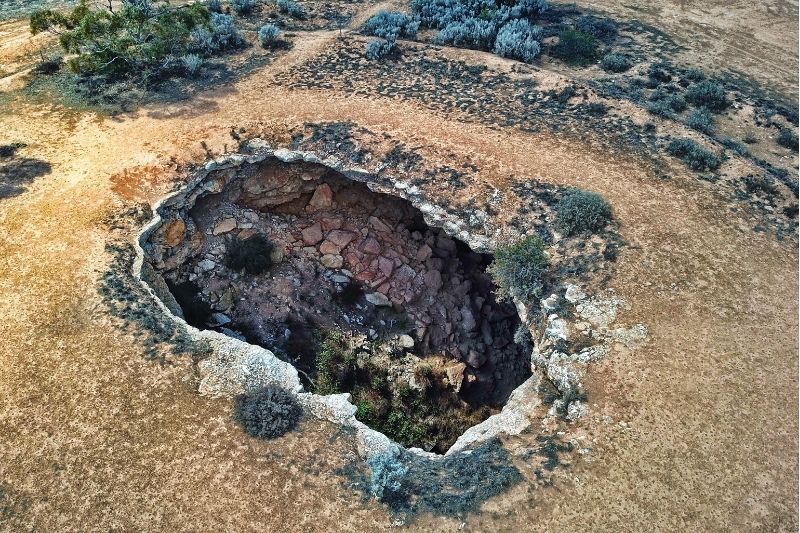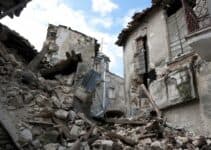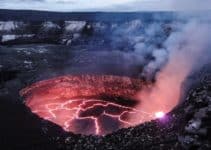By default, the land surface is hard and can support heavy loads, including trucks, buildings, and much more. However, at times, some surfaces are not stable, either due to natural or human causes, and can actually sink several meters into the ground and with them anything initially on the surface, like houses, cars, and roads. These are sinkholes, and this article will describe them in detail.
As the name suggests, sinkholes involve land sinking, causing holes on the ground. These depressions or voids form when water erodes an underlying rock layer, particularly in cases where the rock consists of limestone, salt beds, or carbonate rock.
As the rock dissolves, spaces and caverns develop underground, causing the surface to be susceptible to sinkholes. Sinkholes are very dramatic as land can stay intact for quite some time until the underground spaces get very big. If there is not enough support for the land above the spaces, a sudden collapse of the land surface will occur, resulting in sinkholes.
Sinkholes can vary significantly in size depending on factors like location and underground damage, ranging from small dimensions of about one meter in depth and width to large, expansive ones that can extend hundreds of feet in depth and width.
One of the largest sinkholes known is in the limestone mountains of Nongle in the Guangxi Zhuang region in southern China. The sinkhole measures 656 ft long, 328 ft broad, and 387 ft deep, and when measured from the access point on the mountain ridge, the sinkhole is even deeper, at 1,476 ft. The world’s deepest sinkhole is in Chongqing, China, reaching down about 2170 feet, translating to 662 meters.
There are two types of sinkholes. The first one forms when the roof of a cave collapses and exposes the underground cavern. The second one forms when water dissolves the rock beneath the soil, creating an underground chasm. Without rock to support it, the layer of soil eventually collapses and creates a hole on the surface.
Additionally, sinkholes can result from both natural and human causes. Man-made sinkholes are created when a city development compromises the structural integrity of an underlying rock. Roads, buildings, and other infrastructure can cause water to collect in certain areas and wash away any supporting layer of rock, resulting in sinkholes.
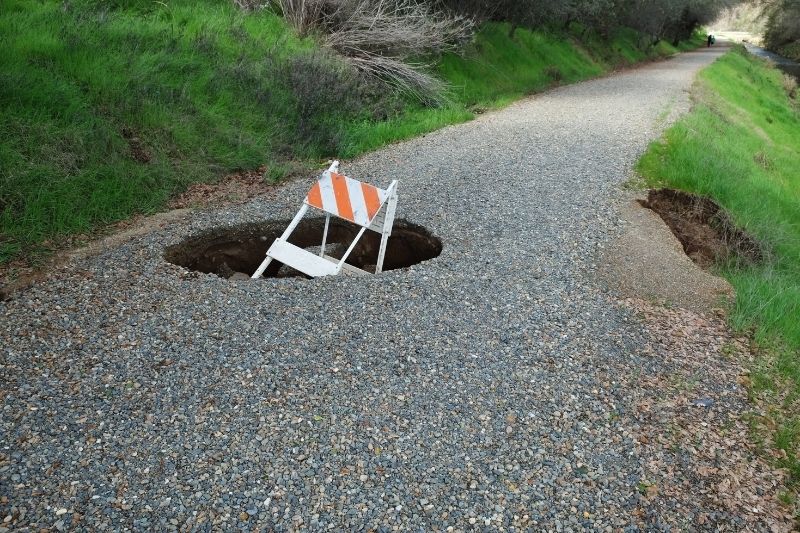
Various Causes of Sinkholes
Some of the common causes of sinkholes include:
1. Water
Water is responsible for about 90% of all sinkholes, and this is how:
Weathering
If the rocks below the surface are made of materials that dissolve in water, like limestone and gypsum, the water dissolves these minerals with time, opening spaces within the rock. This process is known as weathering and results in sinkholes.
Over hundreds or thousands of years, underground water trapped beneath the surface causes natural underground currents that dissolve these rocks and forge chasms under the ground.
The top of the chasm gradually grows towards the surface, and eventually, the surface layer gets thinner and thinner until it becomes too weak to support what is above it and falls in. Mexico’s Yucatan Peninsula and the areas around the Dead Sea are often riddled with sinkholes as the rock layer in the area is easily dissolved.
Non-Soluble Rocks
This occurs when the rock under the surface doesn’t dissolve in water but instead is made of grains that are small enough to be carried away by underground water currents, resulting in sinkholes.
In 2010, in Guatemala City, for instance, a three-story building vanished into a sinkhole, killing 15 people, as the underlying rock was predominantly weak, crumbly volcanic rock, fine ash, and other debris that had erupted from a volcano.
Surface-water
This third situation has nothing to do with underground water currents but is about water movements above ground. They are triggered by intense rainstorms, floods, bursts, or long-term leakage from sewer or stormwater pipes. If these currents are too strong, the water deviates from its usual route, potentially leading to sinkhole formation.
If it travels on a surface without ample support from below ground, it will result in sinkholes. Additionally, the water may settle in one location, causing the surface to become impermeable with water, but as it leaks into the ground, it will result in sinkholes.
Weather Changes
Sinkholes can also result from seasonal changes in the groundwater table, freeze and thaw of the ground, and extreme precipitation, showcased when droughts precede heavy rains.
Changes in The Hydrologic System
Sudden changes to the hydrologic system, such as putting more water in or taking it out, can cause systems to become temporarily unstable, resulting in sinkholes.
Changing Groundwater Gradients
If there is a change in the groundwater gradients, mainly due to the removal or introduction of water to these systems, loose materials can flush out quicker than usual, causing voids, which result in the collapse of the surface
2. Human Activities
Some human activities are resulting in more sinkholes today. For instance, Louisiana is reporting sinkholes forming from abandoned mines. In Florida, many sinkholes result from many underground voids and drainage systems carved from carbonate rocks throughout the state.
A sinkhole is born if these overlaying layers of ground collapse into these voids. Also, drainage systems may break and drain water into these rocks that are weak against such waters. The result will be a sinkhole.
3. Induced Earthquakes
Earthquakes are a natural occurrence, which might result in sinkholes, assuming they hit areas with weak rock below the surface.
However, increased induced earthquakes result from both industrial and human activities, which also cause sinkholes. Careless mining and hydraulic fracking can impact an area, especially its stability and water quality, resulting in earthquakes that result in a sinkhole.
In August 2012, a massive sinkhole opened near Bayou Corne, 77 miles west of New Orleans, and grew to 34 acres in size over four years. The sinkhole was attributed to seismic activity and baffling bubbling on the Louisiana Bayou, which was caused by the Texas Brine Company, which drilled too close to the salt dome’s outer edge.
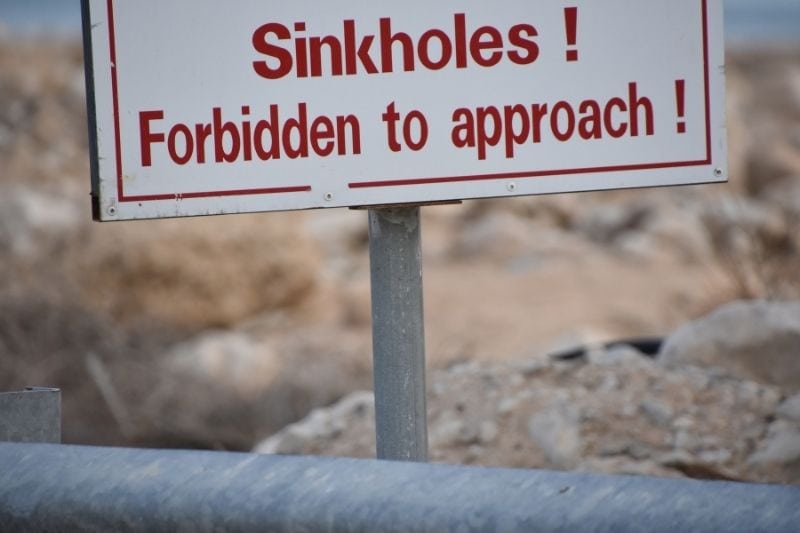
Sinkholes can be natural or man-made. Natural sinkholes occur due to erosion or underground water. They start developing a long time before they actually appear.
The ground beneath our feet is not as much of a solid structure as we think it is. It is made from dirt, along with many rocks and minerals. There is water continually seeping in between the mud, rocks, and minerals as it makes its way down to the groundwater reservoirs.
As this happens, the water slowly erodes the rocks and minerals. Sometimes, the flow of water increases to a point when it washes away the underground structure of the land. When the structure becomes too weak to support the earth’s surface, it collapses and opens up a sinkhole. This is how sinkholes are formed.
Humans are also responsible for the formation of sinkholes. Activities like drilling, mining, construction, broken water or drain pipes, improperly compacted soil after excavation work, or even heavy traffic can result in small to large sinkholes.
Water from a broken pipe can penetrate through mud and rocks, eroding the ground underneath and causing sinkholes. Sometimes, heavy weight on soft soil can result in the collapse of the ground, resulting in a sinkhole. Sinkholes can also form when the land surface is changed.
Areas with bedrock made of limestone, salt deposits, or carbonate rock are most susceptible to erosion and the formation of such holes. These rocks tend to erode as acidic water passes through them. When rainwater passes through decaying plant debris, it tends to become more acidic.
Over a period of years, overlying sediments collapse and a sinkhole develop. Sometimes, the holes are small, measuring a few feet wide and ten to fifteen feet deep. Others can be hundreds of miles wide and deep. However, all of them can be dangerous for those that get caught in them. There are three major kinds of sinkholes. Their formation is determined by the same geological processes, barring a few differences.
Types of Sinkholes
The three major types of sinkholes known to us are Solution, Cover Collapse, and Cover Subsidence.
1. Solution Sinkhole
Solution sinkholes are most commonly seen in areas with a very thin soil cover on the surface, exposing the bedrock below to continual erosion by water. As the water percolates through the bedrock, it carries away small parts of the rock with it. As the bedrock erodes, particles collect in the spaces it leaves.
Over a period of time, a small depression is formed. It is at this point where the hole forms. The hole is usually bowl-shaped and can be quite large. Sometimes, the bedrock may collapse suddenly to form such a solution sinkhole; other times, it happens over time.
2. Cover Collapse Sinkhole
The second kind of sinkhole is known as a Cover Collapse sinkhole. This type occurs when a deep layer of soil and earth covers the bedrock. Once the bedrock begins to get eroded, the crack starts forming in the rocky areas around it. When this happens, several weak points begin forming in the layers of soil and strata above it.
Finally, it comes to a point when the weak points become a large hole within the bedrock that cannot support the weight above it. The cover collapse usually happens in a sudden manner and can create large holes in a matter of minutes.
3. Cover Subsidence Sinkhole
The last kind of sinkhole is known as Cover Subsidence Sinkhole. In this case, the hole is formed over a period of time. The bedrock here is covered by soil and materials which are not well knitted together. Areas that have soil comprising largely of clay or sand often face the occurrence of this hole.
Once the bedrock starts to erode, the clay or sand starts permeating through the cracks and settles into the spaces left behind. Over time, this creates a cavity on the soil’s surface and not under it.
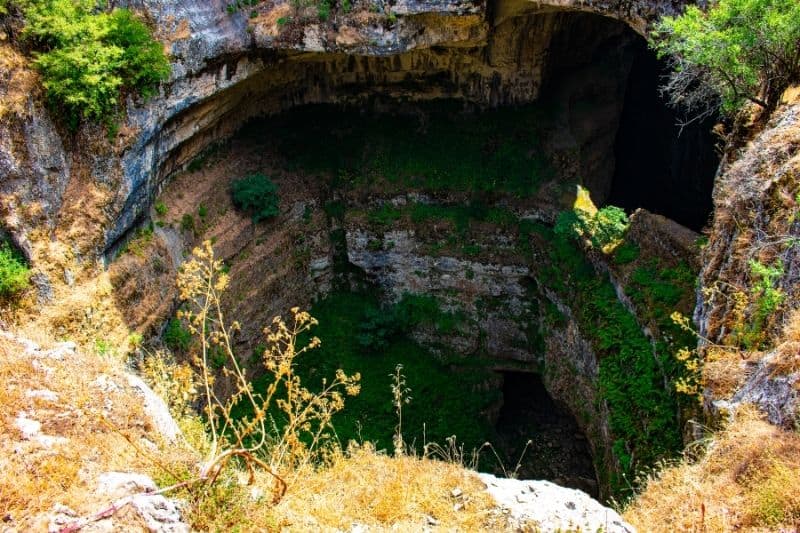
How Are Sinkholes Formed?
Sinkholes can form due to natural processes such as the gradual erosion of underground rock layers, particularly in rocks like limestone, salt beds, or carbonate rock, which can dissolve when groundwater circulates through them. Human activities, heavy rains after drought, natural cracks in the earth’s surface, and other factors can also cause them, as already discussed.
When these conditions are present, the ground may give way, leading to the sudden formation of these depressions or holes in the landscape.
Effects of Sinkholes
The effects of a sinkhole vary depending on where and how it was formed. Natural sinkholes can form on land and in the ocean as well. When they are formed on land, they can change the area’s general topography and divert underground water streams.
If they form suddenly in areas with a heavy population, they can cause a lot of damage to human life and property. Some holes are formed due to the leak in underground storm drains and sewer systems. When they collapse, the damage can be seen for many miles due to the repairs that become necessary.
Sinkholes can also be dangerous to the foundations of the building. Toxic chemicals beneath the earth can come up and may pollute the groundwater. Sinkholes occur commonly in Florida as the state has many underground voids and drainage systems carved from the carbonate rocks.
Natural sinkholes cannot be prevented, as they are bound to occur. However, the ones caused due to human negligence can be prevented in time. Practices such as maintaining the underground systems and plumbing are the best to ensure that a sudden deep hole does not appear in the middle of a city!
Where Do Sinkholes Occur?
Sinkholes can occur anywhere in the world if the conditions favor it. However, they are concentrated in certain areas, and here are some of these areas with some notable sinkholes:
1. Crveno Jerezo, Croatia: There is a 530m sinkhole with nearly vertical walls
2. Great Blue Hole in Belize: It is a perfectly round hole in the middle of an atoll that is 124m deep
3. Sima Humboldt, Bolivia: There is a 314m deep crater, formed from extremely resistant sandstone
4. Xiaozhai Tiankeng, China: This is by far the deepest sinkhole known to date. Tiankeng is the local term for ‘heavenly pit’, or sinkhole. The Xiaozhai sinkhole measures 662m deep and 626m wide
5. Bowling Green, Kentucky: In 2014, a 40ft wide and 20ft deep sinkhole opened under the floor of the Skydome area of the National Corvette Museum, causing eight rare and one-of-a-kind Corvettes to sink. The vehicles were estimated to be worth over a million dollars. Other US states that are prone to sinkholes include Florida, Pennsylvania, Tennessee, Texas, California, Missouri, and Alabama.
6. Guatemala City, Guatemala: The sinkhole swallowed a three-story factory, killed 15 people and measured approximately 60ft wide and 300ft deep. It was triggered by tropical storm Agatha but it was because the city was built in a region where the first few hundred meters of the ground is made up of pumice fill, a material deposited during past volcanic eruptions
Can a Water Leak Cause a Sinkhole?
Yes, a water leak can potentially cause a sinkhole. When water from a leak accumulates underground, it can saturate the soil and weaken the underlying rock or sediment layers. Over time, the combination of water pressure and erosion can lead to the collapse of the ground above, resulting in the formation of a sinkhole.
This is particularly common in areas with underground pipes or sewage systems, as leaks from these systems can create voids in the ground and increase the risk of sinkhole formation.
In most circumstances, it takes a very serious leak to create a sinkhole unless the water condition beneath your home is very unusual. Nonetheless, there are warning signs of an impending sinkhole on your property before it falls through. To understand if there is a leak in your home that could one day result in a sinkhole, look out for the following signs:
- Cracks in the foundation;
- Decreased water pressure in the home;
- The home is leaning;
- You hear water running, especially when it should not;
- Cracks in the driveway and sidewalks;
- A growing water bill than usual;
- Areas on your lawn are becoming greener or browner than normal;
- The doors do not close properly
References:
https://www.dep.pa.gov/Citizens/My-Water/Sinkholes/Pages/What-causes-a-sinkhole.aspx
https://www.nationalgeographic.com/environment/sinkhole/
https://www.theguardian.com/environment/2014/feb/20/are-humans-causing-more-sinkholes
